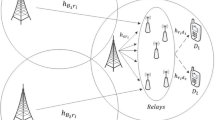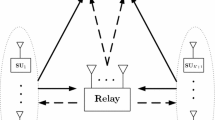Abstract
The principal purpose of this paper is to develop a joint relay selection and power allocation algorithm in cooperative cellular networks with multiple users assisted by multiple relays. By solving a rate optimization problem, we can obtain the optimal solutions and the distributed implementation based on the primal-dual decomposition. An admission control algorithm is also presented when there exists the minimal rate requirement for each user. Simulation results indicate that the algorithm with joint design is superior to the existing ones with isolated design in large total transmission rates and small deviations. Moreover, with the admission control algorithm, the rate requirements for users participating in cooperation are also satisfied.
Similar content being viewed by others
References
Sendonaris A., Erkip E., Aazhang B. (2003) User cooperation diversity-part I: System description. IEEE Transactions Communications 51(11): 1927–1938
Sendonaris A., Erkip E., Aazhang B. (2003) User cooperation diversity-part II: Implementation aspects and performance analysis. IEEE Transactions on communications 51(11): 1939–1948
Laneman J. N., Tse D. N. C., Wornell G. W. (2004) Cooperative diversity in wireless networks: Efficient protocols and outage behavior. IEEE Transactions on Information Theory 50(12): 3062–3080
Bletsas A., Khisti A., Reed D., Lippman A. (2006) A simple cooperative diversity method based on network path selection. IEEE Journal on Selected Areas in Communications 24(3): 659–672
Zhao Y., Adve R., Lim T. (2007) Improving amplify-and-forward relay networks: Optimal power allocation versus selection. IEEE Transactions on Wireless Communications 6(8): 3114–3123
Wang B., Han Z., Liu K. J. R. (2009) Distributed relay selection and power control for multiuser cooperative communication networks using stackelberg game. IEEE Transactions on Mobile Computing 8(7): 975–990
Zhang G., Cong L., Zhao L., Yang K., Zhang H. (2009) Competitive resource sharing based on game theory in cooperative relay networks. ETRI Journal 31(1): 89–91
Han, Z., Himsoon, T., Siriwongpairat, W. P., & Liu, K. J. R. (2005). Energy-efficient cooperative transmission over multiuser OFDM networks: Who helps whom and how to cooperate. In Proceedings of IEEE WCNC (Vol. 2, pp. 1030–1035). New Orleans, USA, 13–17 March, 2005.
Yang N., Tian H., Zhang P. (2008) A service-differentiated random access strategy for multi-channel cooperative relaying networks. Wireless Personal Communications 47(4): 479–495
Chiu-Yam Ng T., Yu W. (2007) Joint optimization of relay strategies and resource allocations in cooperative cellular networks. IEEE Journal Selected Areas in Communications 25(2): 328–339
Tang Z., Zhu Y., Wei G., Zhu J. (2009) An OFDMA-based subcarrier and power allocation scheme in wireless cooperative cellular systems. Wireless Personal Communications 48(2): 277–289
Vardhe K., Reynolds D., Woerner B. (2010) Joint power allocation and relay selection for multiuser cooperative communication. IEEE Transactions on Wireless Communications 9(4): 1255–1260
Kadloor S., Adve R. (2010) Relay selection and power allocation in cooperative cellular networks. IEEE Transactions on Wireless Communications 9(5): 1676–1685
Bertsekas D. P., Tsitsiklis J. N. (1997) Parallel and distributed computation: Numerical methods. Athena Scientific, MA
Tang, M., Long, C., & Guan X. (2010). Nonconvex optimization for power control in wireless CDMA networks. Wireless Personal Communications. doi:10.1007/s11277-009-9909-7.
Yu W., Lui R. (2006) Dual methods for nonconvex spectrum optimization of multicarrier systems. IEEE Transactions on Communications 54(7): 1310–1322
Wang R., Lau V. K. N., Lv L., Chen B. (2009) Joint cross-layer scheduling and spectrum sensing for OFDMA cognitive radio systems. IEEE Transactions on Wireless Communications 8(5): 2410–2416
Multi-hop relay system evaluation methodology. [Online]. Available: http://ieee802.org/16/relay/docs/80216j-06_013r3.pdf.
Author information
Authors and Affiliations
Corresponding author
Rights and permissions
About this article
Cite this article
Ma, K., Liu, Z. & Guan, X. Joint Relay Selection and Power Allocation for Cooperative Cellular Networks. Wireless Pers Commun 64, 305–321 (2012). https://doi.org/10.1007/s11277-010-0200-8
Published:
Issue Date:
DOI: https://doi.org/10.1007/s11277-010-0200-8




